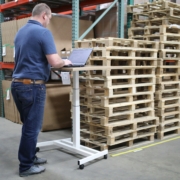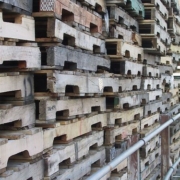As issues related to climate change, recycling of resources, and carbon emissions become ever more important to the public, many companies are being guided by the present social awareness and political initiatives to implement more sustainability practices into their normal business operations.
Additionally, many C-suite executives of companies are using their leadership to focus on corporate social responsibility plans that incorporate sustainability to save energy, reduce waste, and find alternative uses for the byproducts of their processes. One of the key areas for this exercise is in a company’s supply chain.
A successful sustainable supply chain operates by generating competitive returns on the use of its’ assets without forfeiting the requirements of internal stakeholders and the external partners that are a part of that chain. This is accomplished with legitimate concern for the effect of those operations on the environment and all the people involved.
A fundamental question that arises is how to connect the practice of sustainability with supply chain operations in a way that is meaningful, measurable, and manageable. Enter the “Triple Bottom Line” (TBL) or the three P’s – People, Planet, Profits. In today’s post at Nature’s Packaging, we will take a look at the Triple Bottom Line and how the wooden pallet industry plays an integral part in sustainable supply chains.
What Is The Triple Bottom Line?
In the mid-1990’s, author and activist John Elkington worked to develop an accounting framework that aimed to measure the impact of a company’s operations along three dimensions: service to community, environmental impact, and economics. Rather than focus solely on the bottom line as profit, companies needed to enact sustainable development and tie it to corporate social responsibility as a means to holistically make the world a better place. The end result, according to Elkington and other adherents, is a positive outcome for all stakeholders and customers that improves business operations.
“Sustainable development involves the simultaneous pursuit of economic prosperity, environmental quality, and social equity. Companies aiming for sustainability need to perform not against a single, financial bottom line but against the triple bottom line”-John Elkington
Corporate Leadership & TBL
When the triple bottom line of people, planet, profits are put into action in supply chain operations, the values outlined are determined by a company’s mission statement, strategy, management, owners, partners, and customers. Each one of these segments aids in creating the tactics, functions, goals, and expectations that demonstrate a commitment to the policies and guidelines developed in a sustainability plan.
It is the job of executive leadership to properly articulate a program that includes consistent feedback from the ground floor upward as each level, from the warehouse worker to C-suite themselves, will need to understand their role and how it may change in order to execute effectively overall.
Fundamentally, an active supply chain sustainability plan incorporates lean management principles as it is utilized to identify and eliminate waste in process and materials. This means that quantitatively, a measurement of the elements mentioned previously (tactics, functions, goals, and expectations) according to a TBL framework, involves assigning a financial criterion to outcomes that are desired and align to a sustainability model.
People, Planet, Profits, Pallets
To put the above statements in more concrete terms and involve an aspect of financial criteria, it is best to take examples that are easily identifiable in terms of not only supply chain operations, but business operations overall as they often can overlap in achievement of goals.
For example, one method of pegging sustainability as a people-oriented goal in supply chain operations can be reduction of lost workdays due to injury. In fact, this is very often in used in warehouse and manufacturing settings when it is noticeably posted in a high traffic area for all the workers to see. Another way is to measure improvements to worker safety by logging all warnings issued and comparing the volume over a set period of time.
More intangible, but no less important, would be opportunities for education that advances the skillset of workers on the floor and allowing managerial staff to play the role of mentor. All of these initiatives are measurable in terms of participation and can improve the quality of work and output by staff.
In a larger sense, especially as it relates to environmental impact (read: planet), sustainability can be measured in the amount of energy used by various facilities and assets, and the source of the energy itself. In example, many warehouse facilities are incorporating solar energy as an on-site source.
Another example, overall usage of resources like water and tracking the amounts utilized in various processes within the supply chain. The recycling and re-use of various packaging used in the transportation of materials throughout the supply chain is another common metric and easily adapted to sustainability goals.
Sustainability in terms of profits can be measured as an end result to all the initiatives implemented in a TBL-based plan. This includes measuring the level of efficient use of revenue from top to bottom line in reference to sustainability goals from a business unit perspective (supply chain operations, production, administrative, etc.).
In supply chain operations, the utilization of assets and warehouse throughput as measured in key performance indicators against the framework of triple bottom line is one way to integrate sustainability goals to performance goals.
Pallet management operations for customers are a perfect fit in terms of sustainability goals. The pallet industry lends itself quite well to achieve of those goals as a natural part of supply chain operations. Standard operating procedure in a pallet management scenario includes tracking of materials as recycling and re-used.
Additionally, documents like the Pallet Environmental Product Declaration and the Life Cycle Assessment add to the credibility of both the service provider and the customer. Further, The Nature’s Packaging website offers tools like the carbon calculator that gives a tangible sum to pallet recycling efforts by customer companies and their direct positive effect on the carbon emissions of a company’s operations.
In supply chain operations, the triple bottom line to sustainability is a path built by the stakeholders, both inside and outside of the organization. The path advances as growth and improvements are recognized in business units, employees, leadership, and the learned development of best practices in sustainability. Triple bottom line supply chain practices lead to innovation and progress. These in turn create real profit and higher quality standards throughout the chain. As always, the wooden pallet and container industry stands ready, willing, and able to assist in the effort.

















